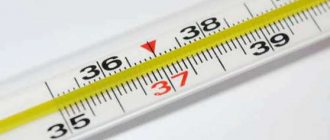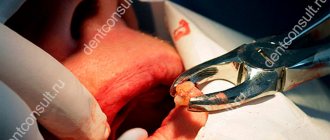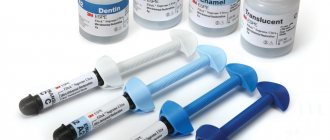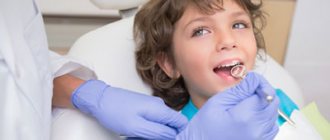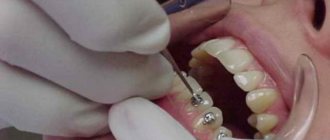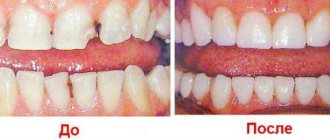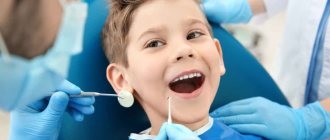Baby teeth are very important. We have more than once encountered the reaction of parents in a situation where they bring a child with advanced multiple caries. “How much will it cost to cure eight teeth? No, I won’t, because of compulsory medical insurance they will snatch everything for free.” Unfortunately, parents often do not understand that the loss (or loss) of primary teeth is very critical for the formation of a healthy orthognathic bite.
The chain is quite simple:
- The tooth was removed much earlier than the date of its replacement.
- The adjacent teeth turned and tilted to close the defect.
- The growth of the jaws has slowed down or stopped, as they depend on the chewing load.
- The permanent teeth erupted with defects, as the rudiments were damaged by infection.
- In adolescence, we have complex dental anomalies and very, very expensive orthodontic treatment that lasts for years in order to somehow correct this.
Therefore, today I will tell you what you need to do for free with your child at the start, so as not to spend a lot of money and effort on treatment in the future.
How many teeth does a child have?
teeth in a six and a half year old child.
The first chewing permanent teeth have appeared, but the incisors have not yet erupted. If you do not take supernumerary “bonus” teeth, then a person usually has 28–32 permanent teeth and 20 milk teeth. That is, at the moment shortly before the first change of teeth, a child has up to 52 teeth simultaneously in his jaw. I am still surprised when I see X-rays of the jaws of children aged six to nine years old. Sometimes there is a feeling that there are more teeth there than the jaw itself.
The skull in children has a peculiar shape. It is difficult to pass through the birth canal, the pelvis is narrow, and the head is rather large. You need to save on something so as not to get stuck along the way. You can't really save money on brains. They should immediately be sufficiently developed. As a result, evolution came to the mechanism of movable skull bones, which run over each other like tiles. The real savings in head size come from the front of the skull. Children have very small upper and lower jaws, and their teeth are in the form of tiny rudiments. This allows us to be born with minimal problems, but it also means that we need to grow these same jaws over the next few years of life. And this is where the difficulties begin.
Jaw width growth is regulated primarily by load. And this is where parents often make two important mistakes.
At first, when refusing breastfeeding, they often choose a nipple with a large hole to make it easier for the child to eat. And children are very lazy. If they understand that they can no longer pretend to be a vacuum installation, trying to eat everything that was synthesized for them in the breast, then they quickly begin to spit at the sight of a natural nipple and demand a bottle. The effort required for sucking is very great. It’s not for nothing that children have such huge cheeks because of Bisha’s fatty lumps. There is a theory that they need hamster cheeks so that the tissue can withstand the sucking process without consequences. And some brown fat to warm your head.
The second mistake occurs when the child’s first teeth appear. At this age they are very curious and try to try everything they see. Especially if one of the parents eats it in front of them. At a friend's house, a child was cracking a hefty piece of shish kebab, about 100 grams long, when the adults turned their backs. Moreover, so far there were only upper teeth. This did not bother him, and he simply removed the shavings from it, like a lathe. In general, this is a normal process. Problems begin when a child chokes on a piece of apple or carrot a couple of times. Nervous parents immediately return to pureed and crushed foods. And children are lazy, as you remember. Chewing is difficult, you have to strain. Very quickly, a one-year-old child can begin to depict his painful death from a terrible piece of pear and demand homogeneous cereals and purees.
Possible complications after nerve removal
Parents often associate complications that arise after removal with the low level of professionalism of the dentist who performed the procedure. They begin to ask another question: is the nerve always removed correctly? Perhaps this procedure is associated with certain risks? Indeed, this kind of thing happens. The need to seek re-treatment may arise in several cases:
- Re-infection, which became possible due to insufficient treatment with an antiseptic.
- Destruction of the installed filling, which was caused by a poorly performed filling procedure.
- Compression of the tooth root by an installed filling.
- A root fracture that can occur if the dentist works too hard with various instruments on the surface of the pulp.
Of course, this doesn't happen very often.
However, if the child complains that the pain does not go away, but rather gets worse, you should visit the clinic again. Never ignore your child’s words that something hurts! Moreover, never resort to painkillers. After all, pain is a consequence. To get rid of it, you need to look for the cause. And only a qualified dentist with enough experience can do this. Moscow metro station Zvezdnaya, Danube Avenue, 23
Jaws don't grow because of soft food
One of the options for underdevelopment of the lower jaw. Specific “bird” profile.
The same patient. Stereolithography of the skull.
Reducing the load below the intended one leads to two very unpleasant consequences. The jaws begin to lag behind in development. As a result, lower and upper micrognathia is formed - underdevelopment of the jaws. The photos above show a very tough case. Most often this is a consequence of concomitant genetic disorders. But even on a less impressive scale, this is a wild headache for orthodontists. You can simply move and tilt individual teeth. It is almost impossible to adjust the position and size of the jaws, especially in adulthood. You will have to break bones, reshape the position of muscles, joints, tongue and much more.
Why are baby teeth needed?
Milk teeth are involved in the development of functions in the child such as chewing and pronunciation of sounds. Without them, chewing hard food would be impossible. The aesthetic component plays an important role.
Also, baby teeth hold space in the dentition for permanent teeth. The eruption of primary teeth stimulates the primary growth of the jaws. The second wave of jaw growth begins during the period of replacement of baby teeth with permanent ones. Early removal of primary chewing teeth leads to the displacement of neighboring teeth into the area of the missing one and the formation of crowding of teeth in the future!
Soft foods will cause tooth decay
This is the second consequence of feeding exclusively soft cereals and purees, when it is time for the child to chew solid food.
A colleague already talked about this in a post about caries. When we chew hard stems or gnaw on roots, we clean off plaque. In addition, there is a micro-massage of the gums, which improves their blood circulation and prevents the formation of tartar under the gums. The child should chew intensively and not drink instant cereals, jelly and banana puree. As a rule, if you see a child with severe multiple caries, then his diet will almost certainly consist of soft buns, cookies and all sorts of instant cereals. Well, in general, hygiene is also not very good.
Symptoms
Inflammation occurs in acute and chronic forms. Acute occurs less frequently, but has more severe symptoms and occurs in two stages:
- serous. The inflamed pulp is filled with serous fluid. There are complaints of severe pain in the tooth, intensifying at night and when chewing. The pain, as a rule, is intermittent, appears once and subsides. Most often, the process occurs in teeth with unformed or absorbable roots. After 5–6 hours, a transition to another stage occurs;
- purulent. Pus forms in the tissues, which begins to melt cells and tissues. The severity of the condition is influenced by immunity, dental condition, and bacterial activity. If the pus has an outlet in the form of a carious cavity or fistula, then the pain is mild. In the absence of outflow, the pain syndrome is bright and long-lasting, intensifying when chewing or eating cold or hot food. The general condition may worsen and fever may appear.
Chronic pulpitis occurs after acute pulpitis or on its own and is characterized by vague symptoms. Pain can only occur under unfavorable factors - cold or hot, too sweet food. The child begins to chew on one side, an unpleasant odor appears, and a bursting and pressing sensation occurs.
The danger of this form is that it is almost asymptomatic. Because of this, inflammation affects more and more tissues. Chronic pulpitis is of three types:
- fibrous. The lightest and most common form. Fibrous tissue grows, the pulp may bleed, and episodic pain appears from mechanical and thermal contact;
- hypertrophic. Develops with severe destruction of the tooth crown. Pathological growth of pulp tissue occurs, which fills the carious cavity;
- gangrenous. The most severe form, accompanied by pulp necrosis. The tooth becomes gray and bad breath appears due to tissue decomposition.
How does the process of changing teeth go?
The process of formation of the facial bones of the skull. Notice how the facial bones of the skull grow and become larger
.
As we develop, our jaws gradually grow, making room for permanent teeth. Children have a small skull, but a lot of teeth. And everyone must slide along complex trajectories in time towards the oral cavity, triggering the resorption of their milk predecessor. Root resorption is the process of dissolution of the roots of primary teeth under the constant pressure of the developing permanent teeth.
Lower fourth milk tooth. The roots are still there, as you can see, since it was removed before.
Due to the fact that we all at one time spat out baby teeth without roots, many have the erroneous understanding that baby teeth, in principle, do not have them. And the indigenous ones are already permanent. In fact, they have normal roots, only they are usually spread out to the sides to make room for a permanent bud. Often, as a result, parents think that they are almost being deceived when it comes to cleaning and filling the canals of baby teeth. “What channels? These are baby teeth, there aren’t even roots!” We have to show x-rays.
If we look at the orthopantomogram, we will see that the permanent teeth initially do not have a formed root. These are the so-called “cap” and “bell” phases. That is, when a tooth has just erupted, it does not have a thin exit from the root canal, but a huge wide hole. The process of final root formation will be completed only a few years after eruption. This is a wild problem for a dentist if the tooth requires depulpation and work in the canals. Normal endodontics is almost impossible.
Anatomy of different types of temporary teeth
- Incisors.
- Fangs.
- Molars.
Eight temporary incisors have the same structure - a fairly flat crown and 1 root. The incisors of the upper dentition, like the rest of the teeth, are larger than the lower ones. In the center, the incisors have one canal, and in 93% of cases, the lateral ones have two.
The four temporary canines are distinguished by a slightly sharp crown on all sides and the longest root. The crown of the canine preceding the permanent one is shorter and convex. The root has a rounded shape in cross-section and a slightly curved apex towards the buccal direction.
Each of the eight teeth of this type has a multi-cusped chewing surface and ends in several root canals. These are the largest teeth in childhood. The second molars are always larger than the first, which cannot be said about similar molars.
How does caries work in a child?
The most acute form of caries. Please note that there is no usual dark coloring. Fabrics simply fall apart faster than they can accumulate pigment.
The course of caries in children is radically different from that in adults. They have weakly mineralized enamel and very loose, permeable dentin. Bacteria that synthesize organic acids consume the tissue of baby teeth at an incredible speed, if only they have managed to gain a foothold. Classic chronic caries almost never occurs in children. Chronic caries is when it develops so slowly that it manages to be stained by tea, coffee, cigarettes and borscht. The result is the classic, familiar black dots on the teeth. If you probe them, they give in, but are still quite dense. But children have uncolored caries. Can not get in time. When probing, it resembles rotten wood, which crumbles into layers under the instrument. As a result, it can take a little more than a month from the beginning to the complete fracture of the crown.
Because of its tenderness, children's enamel is especially vulnerable to the malicious microflora of the oral cavity of adults. The worst scenario is when a grandmother or grandfather with a mouth full of carious teeth tries to see if the child’s food is hot with his own spoon. As if there is no other way to measure temperature. It would be better to even dip your finger. Therefore, make sure that the child has his own separate spoon, which no one but him uses.
Very often, when caries is identified, the question arises about the advisability of treatment. “Let’s get through it, it’s still milky! I had all my teeth pulled out when I was a child, there’s no point in treating it anyway.” You look at your mother, and there is an impressive malocclusion and defects in the development of the jaws. In fact, there is no point in removing a carious tooth without any additional action if it is about to change anyway. In other cases, there are two options: we either treat fully, or we remove a completely hopeless tooth, but come up with a temporary structure to close the defect. Baby teeth take longer to work than they think. The same fangs change at 12–14 years of age! And without them, the bite will simply move away and become asymmetrical. There will be inevitable deformities and joint problems.
It is also impossible not to treat. This is simply dangerous. The infection will go deeper and can destroy the germ of the permanent tooth under the diseased milk tooth. In a very severe case, the infection can result in phlegmon, mediastinitis and sepsis. There are very wide spaces for its distribution throughout the fatty tissue.
So, given the speed of spread, there cannot be any options of “let’s continue like this for a couple more months.” Moreover, there is already excellent anesthesia, and masks with nitrous oxide, and sevoflurane, if the case is advanced and more than 10 teeth have to be treated at a time. Fortunately, a well-working team can carry out such a large-scale treatment in just a couple of hours. If you are interested, you can look at one of the previous posts, a colleague there spoke in detail about nitrous oxide and anesthesia.
Milk units in adults
It happens that doctors discover temporary units in the permanent dentition. Why are baby teeth sometimes retained in adults?
It's all about a dental anomaly, in which the rudiments of the molars, molars, premolars or canines are missing. Then the permanent teeth do not put pressure on the children's teeth. There is no loosening of the latter. As a result, even at thirty years old, a dentist can find a “hello” from a carefree childhood in the patient’s mouth.
Prevention
The classic question: “When should you start brushing your teeth?”
At once. From the very first eruption. Here, of course, you will have to select games with children so that this does not turn into an unpleasant procedure. Let him try different types of toothpastes, brush his teeth with a plastic horse, and the like. To start, it is convenient to use silicone brushes that fit on your finger. And you still need to keep an eye on them, even if they already brush their teeth themselves. Believe me, they often brush their teeth terribly. Buy a plaque indicator - it's a dye. You can simply rinse your mouth with it and rinse with water. Uncleaned plaque will remain brightly colored. Unfortunately, so does the language for a while. Therefore, you can simply apply it to your teeth with an ear stick.
How to save
Caring for a child's smile should begin from the moment the very first incisor appears. Even then, parents must purchase a special device - a finger brush - to carry out hygiene procedures.
Children who are two or three years old need to buy a regular toothbrush. It would be good if it had soft bristles. Mom or dad must control that the baby efficiently cleans the enamel from plaque.
Twice a year, a preschooler should be taken to a pediatric dentist. Very often, caries develops unnoticed. Only a doctor can see it and prevent its spread.
Particular attention should be paid to diet. You should not feed your child sweets; give him candy often. But children need to be taught to eat fresh vegetables and fruits from childhood.
Children who have their own dentist from the age of three always have healthier teeth. They react as calmly as possible to all medical manipulations. Therefore, a lot depends on the parents.
How to recognize the problem and is emergency treatment required?
Due to the reduced sensitivity of the pulp, pain during inflammation may be mild and not cause severe discomfort. In this case, the process of tissue destruction occurs rapidly. It is important to visit the dentist regularly and not ignore your child’s complaints of pain when chewing or when eating cold and hot foods.
Treatment for pulpitis should be immediate. The disease is dangerous due to complications - periodontitis or periostitis. It can also spread to a permanent tooth that has not yet erupted and destroy it.
